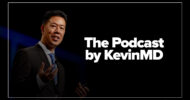Subscribe to The Podcast by KevinMD. Watch on YouTube. Catch up on old episodes!
Medical students Vineeth Amba and Archita Goyal discuss their article, “What’s driving medical students away from primary care?” They share the widespread discouragement medical students encounter regarding primary care careers, despite initial aspirations to serve communities. Vineeth and Archita highlight the ongoing crisis in primary care, evidenced by a decline to just 25 percent of the physician workforce, high burnout rates, and a projected U.S. shortage of approximately 68,000 PCPs by 2036, which impacts patient access for about 100 million people. They argue that underinvestment is a core issue, contrasting the 5–7 percent of health care spending primary care receives with the 35 percent of visits it handles. The discussion explores how increased investment, as exemplified by initiatives in states like Delaware, Rhode Island, and Oregon, and the proposed PC4YOU legislation in Massachusetts, can transform the field. Vineeth and Archita explain that PC4YOU aims to shift to value-based care, mandate 15 percent primary care spending by 2029, and incentivize innovations to improve health equity and make primary care a more sustainable and attractive specialty for future physicians.
Our presenting sponsor is Microsoft Dragon Copilot.
Microsoft Dragon Copilot, your AI assistant for clinical workflow, is transforming how clinicians work. Now you can streamline and customize documentation, surface information right at the point of care, and automate tasks with just a click.
Part of Microsoft Cloud for Healthcare, Dragon Copilot offers an extensible AI workspace and a single, integrated platform to help unlock new levels of efficiency. Plus, it’s backed by a proven track record and decades of clinical expertise—and it’s built on a foundation of trust.
It’s time to ease your administrative burdens and stay focused on what matters most with Dragon Copilot, your AI assistant for clinical workflow.
VISIT SPONSOR → https://aka.ms/kevinmd
SUBSCRIBE TO THE PODCAST → https://www.kevinmd.com/podcast
RECOMMENDED BY KEVINMD → https://www.kevinmd.com/recommended
Transcript
Kevin Pho: Hi, and welcome to the show. Subscribe at KevinMD.com/podcast. Today’s KevinMD article is “What’s driving medical students away from primary care.” Archita and Vineeth, welcome to the show.
Vineeth Amba: Thank you so much for having us.
Archita Goyal: Thank you for having us, Kevin.
Kevin Pho: All right, so Archita, I’m going to start with you. What led both of you to write this article, and then talk about the article itself for those who didn’t get a chance to read it?
Archita Goyal: Yeah, of course. So, I’m currently a fourth-year medical student at Tufts. I’ve always been really interested in policy and advocacy. I studied health policy as part of my undergraduate degree, and when I got to medical school, I knew I wanted to stay involved in that work. So after my first year of medical school, I actually did an internship with Dr. Wayne Altman, who is also our mentor and a co-author on this paper. He couldn’t be here for the podcast today with us.
But that’s how I got involved with and introduced to Primary Care for You. PC for You, which is essentially a bill that aims to reform health care by increasing investment in and access to primary care. So I spent that summer after my first year researching various aspects of this bill, building a website for it, and eventually testified at the Massachusetts State House in favor of the bill as well.
I met Vineeth throughout this process, so he can perhaps tell us a little more about the bill and what led to our article from there.
Kevin Pho: All right, Vineeth, so before talking a little bit about the bill, just talk to us about the context. You are both aspiring to go into internal medicine? I’m in internal medicine as well. I’ve been doing primary care for 23-plus years now, and it seems like there’s always been a primary care shortage ever since I was in medical school and residency. So, Vineeth, tell us about the context. Tell us about the situation, about why something like this, why this bill needs to happen.
Vineeth Amba: So the context for us starting out personally, Archita and I both went through our first, second, and third years of medical school by the time we had actually met. And in our training, we hear from our preceptors, from other physicians, even those in primary care, about how much they’re struggling, how many tasks they have outside of clinical care, and the burnout they’re experiencing.
And at many times, we were even encouraged to leave our pathway into primary care. It was really that personal context that drove us into working in our capacities in this primary care legislative reform, but thinking even broader at a national scale. We know today 100 million people in the U.S. do not have access to a primary care physician on a regular basis.
We know more and more medical students and trainees are opting not to practice primary care, and even those who have hopes of entering primary care in residency often leave that pathway before they end residency. So it was all these contexts—our personal context, the national context—put together that drove us to working on this piece of legislation.
And this piece of legislation would do three things:
- It would increase investment in primary care to aim to achieve 15 percent investment in primary care by commercial insurers by 2029.
- It would shift how we pay for primary care, from fee-for-service to a more value-based care system.
- And finally, it would incentivize primary care providers and physicians to reform and innovate in their practices, whether that be improving teams, improving technology, or improving social supports.
So this legislation really had a triple aim that addressed many of the issues that Archita and I were seeing in our own training.
Kevin Pho: So Vineeth, I just want to get back to one thing you said. So as you were going through medical school and you were going through your rotations, your primary care rotations, you actually had instances where these primary care physicians, obviously overwhelmed, actively told their students not to pursue primary care. Am I hearing that right?
Vineeth Amba: Yeah, as wild as that might seem. Yes, that is exactly what was happening. Luckily, I had a drive to enter primary care before I entered medical school. So I was able to have these types of conversations with my preceptors, but a lot of preceptors, five, 10, or 15 years in, were already experiencing the burdens of primary care practice.
Kevin Pho: So Archita, as I’m hearing the highlights of the bill that Vineeth just mentioned in terms of increasing the investment and shifting more towards value-based care and increasing primary care reimbursement codes, some of that is already happening, right? So, do you feel like we’ve made enough progress over the last few years? Because each of those things is already in motion to some extent.
Archita Goyal: Yeah, that’s a really good question. I think there has been a definite shift from, you know, trying to go to a value-based care model from fee-for-service. We hear that a lot, but the main difference in this is reshifting the focus to primary care itself. Because a lot of times when we talk about value-based care systems, they don’t really focus on the shift to primary care or increasing investment in primary care.
They might focus instead on specific specialty practices or how hospitals are run, but not necessarily the primary care practice itself, which is how this bill is a little different. And I think the reason that it’s important to focus on primary care and how this idea came about is because essentially health starts at the primary care level.
When someone comes into the doctor’s office and they have complaints, the primary care doctor is the first one that sees them and addresses all of these things that are going on. And the goal is, of course, to never have these people end up in the hospital. You want to take care of their health right away and prevent future hospitalizations, future events. And so I think our bill and this investment in primary care is unique and different because it focuses on that first step, giving providers the resources, giving primary care physicians the resources to have the time and the support to adequately treat the people that they’re seeing.
And not be burnt out because, unfortunately, we do see a lot of primary care physicians right now who leave because they’re burnt out because they don’t have the resources and the support to do their job.
Kevin Pho: So, Archita, as you talked about your background in public policy, what makes an initiative like this different from the many other times that we’ve tried to improve conditions and prevent primary care physicians from leaving? What makes this different from prior efforts?
Archita Goyal: Yeah, I think some of the prior efforts, and Vineeth can definitely add to this as well, but a lot of the prior efforts focused on retaining primary care physicians through programs like, let’s say, loan repayment programs or increasing salary. And while those things are important, of course, I think we’ve identified that the core issues are more so in the organizational structure and support, which prior bills didn’t target.
So, as an example, primary care practices can really benefit from having extra support, whether it be through working with community health workers, whether it be working with MAs, or any other kind of resources that can help them streamline their process. A lot of the administrative burden that primary care practices face is not adequately addressed in past efforts. So I think past efforts really focused on one aspect of primary care, which may have been loan forgiveness. It may have been alleviating the burden that way, but they didn’t really focus on the more systemic issues of the actual support and structures that are needed for primary care physicians to practice appropriately.
Vineeth Amba: This bill, in our opinion, is very historic because it’s trying to accomplish three amazing tasks all at once. First, increasing the primary care investment and addressing those systemic drivers. We know from a study in California that increasing primary care investment improves patient satisfaction and reduces unnecessary hospitalizations and ED visits. We know that this investment can actually improve outcomes. We know from Rhode Island, which has already taken steps to increase its primary care investment, that it improves health information technology, the alternative payment models we have at our disposal, and preventive screening tools.
So when it comes to the systemic factors and types of support that primary care physicians need, investment is a way to accomplish those aims. Next, it shifts from fee-for-service to value-based care. We have some evidence that value-based care can generate savings over time. And also, it lets us go back to a way of primary care that was meant to be—a primary care that is relationship-based at the level of the person and not at the level of the service.
And third, it incentivizes primary care providers and physicians with the tools and financial resources to take on those innovative tools into their practice, like community health workers, mental health care professionals, and nutrition support, as Archita has said. So this is really historic and different because we’re trying to address all of these systemic factors pushing people away from primary care all at once.
Kevin Pho: Vineeth, tell us the perspective among your fellow medical students. I know you just finished medical school. What is their view of primary care? Because the traditional thinking from all of my interviews is that medical students have six-figure loans, and then the disparity in payments between specialists and primary care is so large that going into primary care sometimes isn’t economically feasible for a lot of medical students. Is that line of thinking still valid today?
Vineeth Amba: It’s definitely still valid today. You know, I’m sitting here as one of those people with six-figure loans, so I can talk to you from my personal experience. A lot of people definitely still choose their specialties as a result of the financial burden they have incurred, not just throughout medical school, but also undergrad and through their gap years as well.
The other item that drives people away from primary care or drives people away from being interested in primary care is that there might not be as much exposure to the excitement of primary care. Primary care for me was exciting because I got to experience those relationships. Before I came to medical school, I was working in the AmeriCorps program, and there I was working in a free clinic and mobile health clinic where I had those one-on-one interactions in the community.
Not as many people have exposure to those values in primary care and, again, that relationship-building that you can only get in a field like primary care over time. So I think it’s really those two: the lack of exposure to the exciting elements of primary care that you can’t get anywhere else, and the financial burden that might be disincentivizing students from entering this field.
Kevin Pho: Vineeth, what’s the status of the bill currently?
Vineeth Amba: Yeah, so the bill is still being discussed in the legislature. It’s been reintroduced in this current cycle. It’s had a hearing that Archita was able to speak at as well. But right now, it’s still in the deliberations process. The exciting meeting point that Archita and I had was I was working on the bill directly when it came to its implementation and the fine details, and she was doing the advocacy on the outside, trying to push it forward. So it was really there that was our meeting point in the last year of the bill’s iteration.
Kevin Pho: So what was it like to testify and speak at that hearing, and what were some of the responses that you heard from legislators?
Archita Goyal: Yeah, it was a really unique experience. It was the first time I had ever testified in a setting like that. Very interesting because I think at the medical student level, a lot of my colleagues have the thinking that, you know, we’re just medical students, we can’t really have an impact. There’s no use in doing this kind of advocacy or policy work now. If we want to, we can do it later on in the future, later on in our careers.
But this was the first time I had the opportunity to testify with two other medical students at the time as well, just about our perspectives on primary care. From a medical student perspective, what we had seen in rotations, how we see doctors respond to primary care. And I specifically had researched a little bit about the cost savings that we can expect if we invest in primary care.
Doing the research and delivering these facts, but also telling legislators our personal experiences as medical students and what we’ve seen and what we’ve heard, was so impactful. And I think it was a pleasant surprise to see how receptive everyone was to this. I don’t think we had a single person that day speak in opposition to the bill, which was very interesting.
And I think it just goes to show the impact that we can have at any level of training in policy and the impact that combined movements can have on pushing a bill forward. Since then, that summer I was able to make a website for PC for You, which is pcforyou.org, that has all the testimonies that were given that day at the legislation hearing.
And it also just has basic aspects of the bill. And the unique thing I think about this and policy in general is that it can be digestible by any sort of audience. So if you are a medical student, you should be able to understand what’s going on with the bill, but also if you’re a patient and you’re wondering, “How does this affect me and how does this affect my life?” that’s something you can learn from this bill as well. Similarly, if you’re already a practicing primary care doctor, you can learn about how it affects you. So overall, I think it was a really interesting experience, and it just goes to show that policy has lots of different ways that it can influence people’s day-to-day lives.
Kevin Pho: So Archita, I think that one of the biggest things that I see is that, specific with the transition away from fee-for-service to value-based care, a lot of hospitals still depend on that revenue pipeline that fee-for-service provides, right? In our current system where predominantly our payment models are fee-for-service, so how do you resolve that tension that’s there? Like how would you get a wholesale shift towards a value-based payment system?
Archita Goyal: Right. I mean, I think that’s a question that has been debated and talked about a lot because even though there have been a lot of different value-based care models out there, there’s a reason we’re still predominantly fee-for-service, as you mentioned.
And I think it all comes down to the incentives that we’re providing for these hospitals to shift to a more value-based care system and also what resources do these hospitals and practices have. I think from a few studies that I’ve read, just in general about value-based care and the transition from fee-for-service, the issue is that sometimes hospitals cannot afford to have the risk that can be associated with shifting to a more value-based care model.
There are many instances where hospitals are already struggling to break even, and they’re saying, “Well, if we shift to a value-based care system and we’re unable to meet the quality metrics or the quality goals, then how are we going to stay afloat? How are we going to make money?”
So I think that that’s definitely a part of it. I think part of it can also be attributed to the fact that there’s just not enough education as well in terms of what is value-based care. I think value-based care is one of those buzzwords that’s thrown around a lot, but within value-based care, there are a lot of different models that can exist. And that’s also what CMS is trying to do with a lot of their pilot programs that they have to see which one of these value-based care models can be adopted and has positive outcomes.
So in terms of how we actually convince people to shift, I think there are two main ways we can do that. The first would be increasing education around what we’re doing exactly. So in this case, we’re increasing investment in primary care. And second is, why does that matter? Right? A hospital will say, “OK, how does this impact us? Why does it matter?” I think communicating to them that this actually results in long-term savings for you, for your hospital.
Because we’re intervening at the primary care level, that means people will have to go to the hospital less. That means they won’t need as many procedures, they won’t need as many things to be done. And this results in long-term cost savings for not only you, the hospital, but also for insurers who are involved and other payers involved.
So I think seeing the financial impact for insurers and hospitals is really important, but it can also be difficult at a primary care level because primary care is one of those things where it can take years before you see those savings because it takes years to track outcomes.
Kevin Pho: Today’s KevinMD article is “What’s driving medical students away from primary care.” Now I’m going to ask each of you just to share some take-home messages that you’d like to leave with the KevinMD audience. Vineeth, why don’t we start with you?
Vineeth Amba: Sure. I really have two take-home messages from my end. First, since working on this bill, I’ve always known that our primary care was in a crisis, but seeing the numbers on this bill and seeing the numbers on the United States as a whole was very eye-opening for me. But it’s important, I think, for both trainees and for physicians to not be totally pessimistic about what’s to come.
We do have solutions, we do have options. And most importantly, we have a passionate community behind primary care that wants to see improvements for our patients. So my take-home message is that there are policy solutions and policy levers, and that PC for You in Massachusetts, I think, is an excellent framework to accomplish some of our missions.
And then secondly, medical students and trainees do have the power to attack some of the obstacles that our patients face. For Archita and I, that obstacle that our patients faced was access to primary care. And we saw that working in advocacy, writing op-eds at KevinMD, or testifying directly and working in the legislature are not just items that Archita and I have done. Many medical students and trainees have accomplished such advocacy goals in their own issue areas. So being aware of what’s available to you in the advocacy realm, I think is a great step forward for any trainee.
Kevin Pho: And Archita, we will end with you. What are your take-home messages?
Archita Goyal: I think my take-home message, similar to Vineeth’s, you know, advocacy and policy engagement is important at every single level. Whether that is as a medical student, being prior to medical school, entering medical school, or being a trainee, whatever stage that may be. Secondly, a take-home message: I would encourage anyone interested in learning more about primary care or this bill, PC for You, to go to pcforyou.org. There’s a lot of information on this legislation. You can stay up to date on the bill, and there’s a way you can sign up for our newsletter for regular updates as well.
Kevin Pho: Well, thank you. Thanks to you both for sharing your perspective and insight. Thanks again for coming on the show.
Vineeth Amba: Thank you.
Archita Goyal: Thanks so much, Kevin.


























